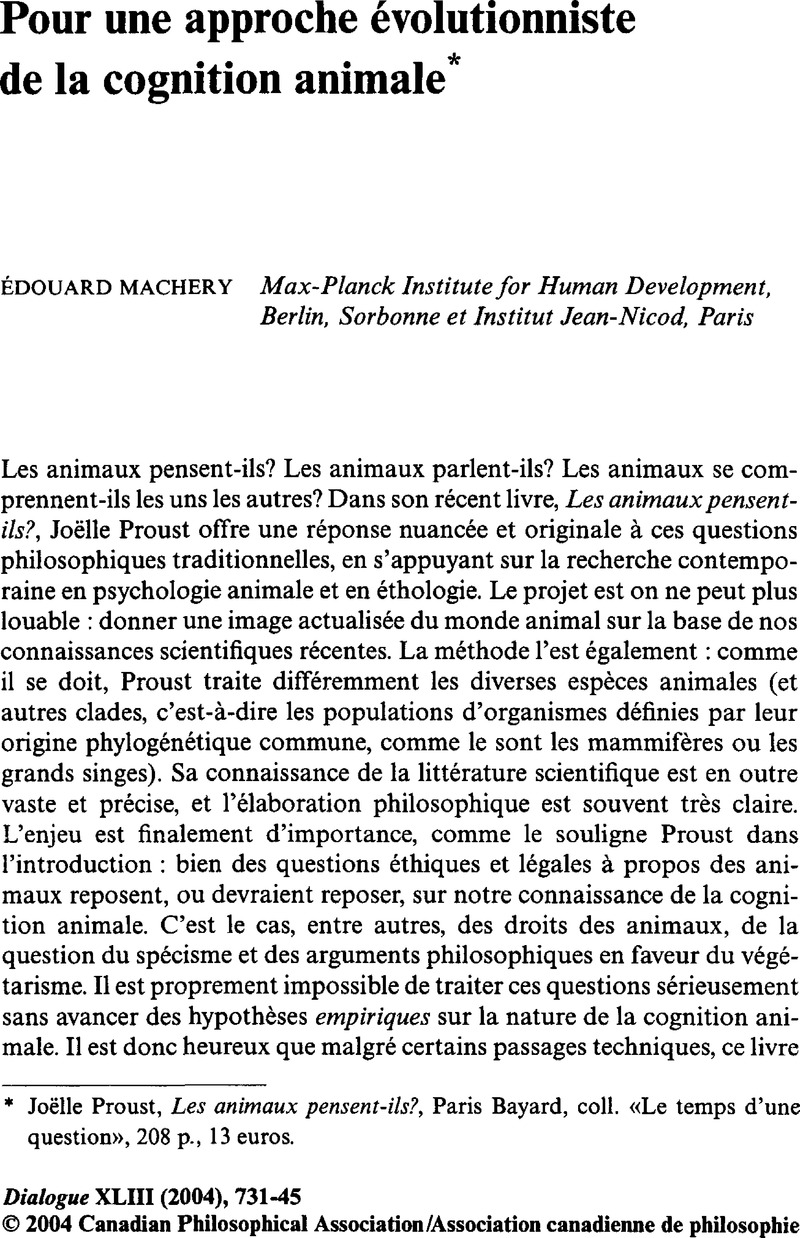No CrossRef data available.
Article contents
Pour une approche évolutionniste de la cognition animale*
Published online by Cambridge University Press: 13 April 2010
Abstract
An abstract is not available for this content so a preview has been provided. Please use the Get access link above for information on how to access this content.

- Type
- Critical Notices/Études Critiques
- Information
- Dialogue: Canadian Philosophical Review / Revue canadienne de philosophie , Volume 43 , Issue 4 , Fall 2004 , pp. 731 - 746
- Copyright
- Copyright © Canadian Philosophical Association 2004
References
Références bibliographique
Allen, C. 2002 «A Skeptic's Progress» (Review of D. Povinelli's Folk Physics for Apes), Biology and Philosophy, vol. 17, no5, p. 695–702.CrossRefGoogle Scholar
Bekoff, M., Allen, C. et Burghardt, G. M., dir. 2002 The Cognitive Animal: Empirical and Theoretical Perspectives on Animal Cognition, Cambridge, Mass., MIT Press.CrossRefGoogle Scholar
Boyd, R. et Richerson, P. J. 1995 «Why Does Culture Increase Human Adaptability?», Ethology and Sociobiology, vol. 16, p. 125–143.Google Scholar
Boyd, R. et Richerson, P. J. 1996 «Why Culture Is Common, but Cultural Evolution Is Rare», Proceedings of the British Academy, vol. 88, p. 73–93.Google Scholar
Call, J. 2001 «Chimpanzee Social Cognition», Trends in Cognitive Science, vol. 5, p. 388–393.Google Scholar
Carruthers, P. 1996 Language, Thought and Consciousness, Cambridge, Cambridge University Press.CrossRefGoogle Scholar
Carruthers, P. 2002 «The Cognitive Functions of Language», Behavioral and Brain Sciences, vol. 25, no6, p. 657–674.Google Scholar
Clark, A. et Karmiloff-Smith, A. 1993 «The Cognizer's Innards : A Psychological and Philosophical Perspective on the Development of Thought», Mind and Language, vol. 8, no3, p. 488–519.Google Scholar
Dawkins, R. et Krebs, J. R. 1978 «Animal Signals: Information or Manipulation», Behavioral Ecology : An Evolutionary Approach, Oxford, Blackwell.Google Scholar
Gallese, V. et Goldman, A. 1998 «Mirror Neurons and the Simulation Theory of Mind-Reading», Trends in Cognitive Science, vol. 2, no12, p. 493–501.Google Scholar
Gil-White, F. 2001 «Are Ethnic Groups Biological “Species” to the Human Brain?», Current Anthropology, vol. 42, no4, p. 515–554.CrossRefGoogle Scholar
Godfrey-Smith, P. 1996 Complexity and the Function of Mind in Nature, Cambridge et New York, Cambridge University Press.Google Scholar
Godfrey-Smith, P. 2001 «Environmental Complexity and the Evolution of Cognition», dans R. Sternberg et J. Kaufman, dir., The Evolution of Intelligence, Mahwah, Lawrence Erlbaum Associates.Google Scholar
Godfrey-Smith, P. 2003 «Folk Psychology under Stress : Comments on Susan Hurley's “Animal Action in the Space of Reasons”», Mind and Language, vol. 18, no3, p. 266–272.Google Scholar
Grafen, A. 1990 «Biological Signals as Handicaps», Journal of Theoretical Biology, vol. 144, p. 517–546.CrossRefGoogle ScholarPubMed
Hare, B. et Wrangham, R. 2002 «Integrating Two Evolutionary Models for the Study of Social Cognition», dans M. Bekoff, C. Allen et M. Burghardt, dir., The Cognitive Animal: Empirical and Theoretical Perspectives on Animal Cognition, Cambridge, Mass., MIT Press.Google Scholar
Henrich, J. et McElreath, R. 2003 «The Evolution of Cultural Evolution», Evolutionary Anthropology, vol. 12, p. 123–135.CrossRefGoogle Scholar
Laland, K. N., Odling-Smee, F. J. et Feldman, M. W. 2000 «Niche Construction, Biological Evolution and Cultural Change», Behavioral and Brain Sciences, vol. 23, no1, p. 131–175.Google Scholar
Machery, É. et Faucher, L. (inédit) «Social Construction and the Concept of Race», à paraître dans Philosophy of Science.Google Scholar
Matsuzawa, T. 2002 «Chimpanzee Ai and Her Son Ayumo : An Episode of Education by Master-Apprenticeship», dans M. Bekoff, C. Allen et M. Burghardt, dir., The Cognitive Animal: Empirical and Theoretical Perspectives on Animal Cognition, Cambridge, Mass., MIT Press.Google Scholar
Maynard Smith, J. 1991 «Honest Signalling : The Philip Sidney Game», Animal Behaviour, vol. 42, p. 1034–1035.Google Scholar
Maynard Smith, J. 1994 «Must Reliable Signals Be Costly», Animal Behaviour, vol. 47, p. 1115–1120.Google Scholar
McElreath, R., Boyd, R. et Richerson, P. J. 2001 «Shared Norms Can Lead to the Evolution of Ethnic Markers», Current Anthropology, vol. 44, p. 122–130.CrossRefGoogle Scholar
Odling-Smee, F. J., Laland, K. N. et Feldman, M. W. 2003 Niche Construction : The Neglected Process in Evolution, Princeton, Princeton University Press.Google Scholar
Perrett, D. et coll. 1990 «Social Signals Analyzed at the Single Cell Level: Someone Is Looking at Me, Something Touched Me, Something Moved!», International Journal of Comparative Psychology, vol. 4, p. 25–55.Google Scholar
Povinelli, D. J. et coll. 2000 Folk Physics for Apes: The Chimpanzee's Theory of How the World Works, Oxford, Oxford University Press.Google Scholar
Povinelli, D. J. et Eddy, T. 1996 «What Young Chimpanzees Know about Seeing», Monographs of the Society for Research in Child Development, vol. 61, p. 1–152.CrossRefGoogle ScholarPubMed
Richerson, P. J. et Boyd, R. 2001 «The Evolution of Subjective Commitment to Groups : A Tribal Instincts Hypothesis», dans R. M. Nesse, dir., The Evolution of Commitment, New York, Russell Sage Foundation.Google Scholar
Rizzolatti, G. et coll. 1988 «Functional Organization of Inferior Area 6 in the Macaque Monkey, II. Area 5 and the Control of Distal Movements», Experimental Brain Research, vol. 71, p. 491–507.CrossRefGoogle Scholar
Silk, J. B. 2001 «Grunts, Girneys, and Good Intentions : The Origins of Strategic Commitment in Nonhuman Primates», dans R. M. Nesse, dir., The Evolution of Commitment, New York, Russell Sage Foundation.Google Scholar
Silk, J. B., Taylor, E. et Boyd, R. 2000 «Cheap Talk about Conflicts», Animal Behaviour, vol. 59, p. 423–432.CrossRefGoogle Scholar
Spelke, E. S. 2003 «What Makes Humans Smart», dans D. Gentner et S. Goldin-Meadow, dir., Advances in the Investigation of Language and Thought, Cambridge, Mass., MIT Press.Google Scholar
Sterelny, K. 2003a Thought in a Hostile World: The Evolution of Human Cognition, Londres, Blackwell Publishers.Google Scholar
Sterelny, K. 2003b «Charting Control-Space : Comments on Susan Hurley's “Animal Action in the Space of Reasons”», Mind and Language, vol. 18, no3, p. 257–265.Google Scholar
Zahavi, A. 1975 «Mate Selection : A Selection for Handicap», Journal of Theoretical Biology, vol. 53, p. 205–214.Google Scholar
Zahavi, A. et Zahavi, A. 1997 The Handicap Principle: A Missing Piece of Darwin's Puzzle, New York, Oxford University Press.CrossRefGoogle Scholar




